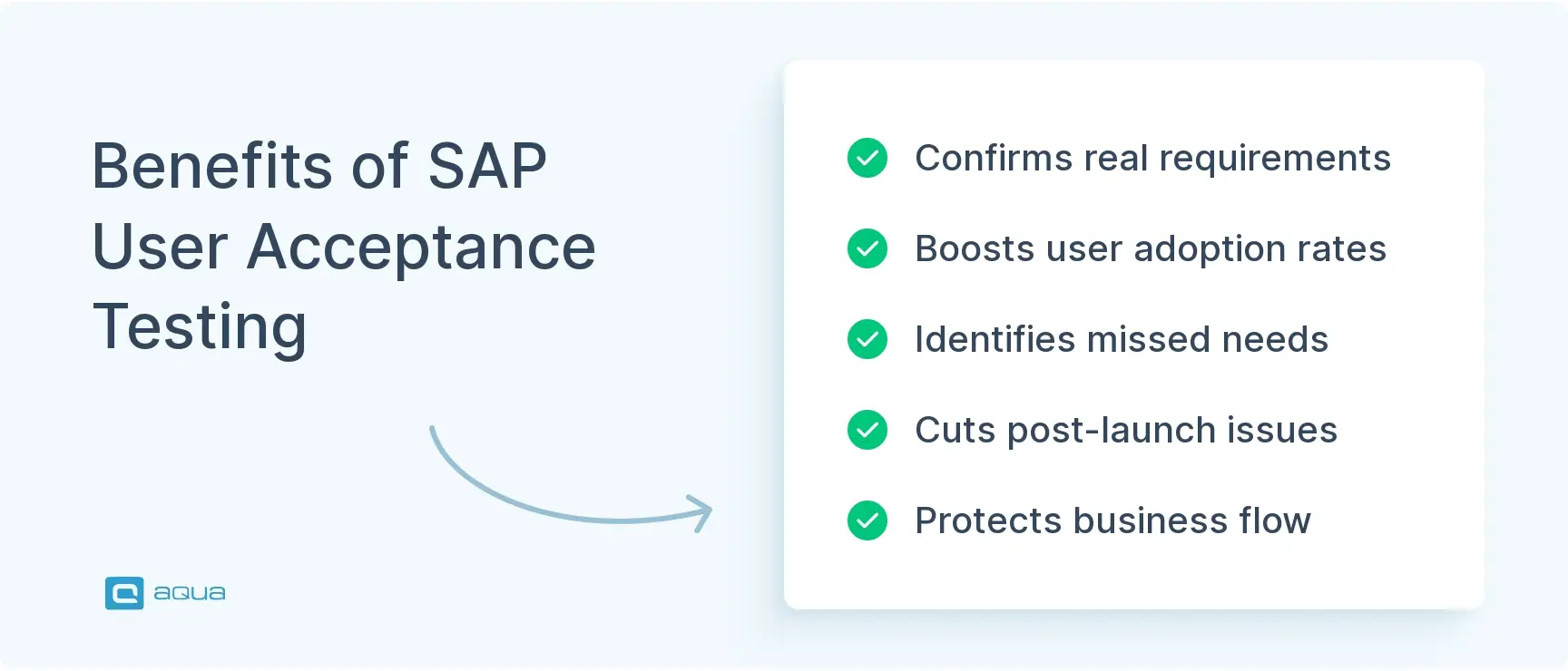Key Takeaways
- User Acceptance Testing in SAP validates whether the implemented system actually supports real business workflows, focusing on business functionality rather than technical features.
- SAP User Acceptance Testing template should be structured around complete end-to-end business processes rather than isolated transactions to reveal integration issues between workflow steps.
- Organizations conducting thorough UAT experience up to 40% fewer critical issues post-launch compared to those that skip comprehensive testing.
- Successful SAP implementations begin UAT planning 3-4 months before testing, with multiple test cycles to catch all issues and validate fixes.
- Professional test management solutions that centralize case management, track defects, and provide real-time progress dashboards are essential for effective SAP UAT.
Many SAP implementations technically work but fail to support how employees actually do their jobs, leading to expensive post-launch fixes and frustrated users. Discover how to run effective User Acceptance Testing that validates your SAP system before it’s too late 👇
What is user acceptance testing in SAP?
User Acceptance Testing in SAP is the final testing phase where actual end users validate that the implemented SAP system meets their business requirements and supports their daily workflows effectively. Unlike technical testing performed by IT professionals, UAT focuses on business functionality from the user’s perspective.
During SAP UAT, users follow predefined test scripts that represent real-world business scenarios to verify the system:
- Functions according to business requirements
- Supports end-to-end business processes
- Provides appropriate interfaces and reports
- Maintains proper security and authorisation controls
- Integrates correctly with other systems
The primary goal is to confirm that the SAP system is ready for productive use from a business perspective, not just technically functional.
Types of Testing in SAP Implementations
SAP implementations involve several testing phases that build on each other. Each phase serves a different purpose, and understanding them helps put UAT in the proper context.
- Unit Testing: Developers test individual pieces of code or configuration changes. Think of it as checking whether each component works on its own before connecting it to anything else.
- Integration Testing: This checks whether different SAP modules actually talk to each other properly. Does sales data flow correctly into finance? Can production planning access inventory information? These connections often break in ways that surprise everyone.
- Regression Testing: When you make changes to SAP, this testing ensures you haven’t accidentally broken something that was working before. It becomes especially important when applying patches or upgrades to live systems.
- Performance Testing: Can your system handle the transaction volumes you expect? Will it slow down when everyone logs in Monday morning? Performance testing answers these questions before users start complaining about slow response times.
- Security Testing: This validates that people can only access what they’re supposed to access. Sales reps shouldn’t see payroll data, and temporary contractors shouldn’t have the same system access as permanent employees.
- Interface Testing: SAP rarely works in isolation. This testing verifies that data exchanges correctly with other systems through various connection methods.
- Data Migration Testing: When moving from legacy systems, this confirms your historical data made the journey intact and usable.
- User Acceptance Testing: The final validation where real business users confirm the system actually supports their work. This is where theory meets reality.
Each phase builds toward UAT, which represents the final business validation before go-live.
What UAT Actually Accomplishes
User Acceptance Testing validates whether your SAP investment will actually help people do their jobs better. Technical testing confirms the system works from an IT perspective, but UAT asks the business question: “Can our people actually accomplish their work with this system?” Let’s look at what it actually aims:
- Verifies Real-World Fit: SAP configurations that look perfect in testing environments sometimes fall apart when people try to use them for actual work. UAT catches these mismatches while you can still fix them.
- Finds the Gaps Nobody Expected: No matter how thorough your requirements gathering, some needs only surface when users interact with the real system. UAT discovers these gaps before they become post-launch emergencies.
- Builds User Buy-In: When people participate in testing, they gain familiarity and develop ownership. This dramatically improves adoption rates because users understand how the system benefits their work.
- Tests Your Training Approach: UAT reveals whether your training materials actually prepare people for real system use or just theoretical understanding.
- Reduces Go-Live Risks: Every problem UAT catches prevents potential business disruption after launch. It’s far cheaper to fix issues during controlled testing than during live operations.
- Creates Formal Documentation: UAT provides official evidence that business stakeholders verified and accepted the system. This protects everyone if questions arise later about what was tested and approved.
UAT serves as your final checkpoint before trusting business operations to the new system. It’s not just another testing phase to complete, but validation that your SAP investment will actually deliver promised business value.
As you navigate the challenges of SAP UAT, implementing the right test management solution can be the difference between a smooth go-live celebration and post-launch firefighting. aqua cloud provides a specialised platform that seamlessly supports even the most complex SAP UAT processes. With AI-powered test case generation, you can transform business requirements into comprehensive UAT scenarios in seconds, saving up to 97% of preparation time while ensuring complete coverage of your SAP modules. aqua’s centralised approach allows you to manage both manual UAT and automated regression tests in one place, with end-to-end traceability from requirements to test results. For SAP implementation teams, this means every business process is validated, every defect tracked, and every approval documented, providing the transparency and governance that leadership demands for confident go/no-go decisions. Integrations like Jira, Confluence, Azure DevOps enhance your toolkit, while automation integrations like Selenium, Jenkins, and Ranorex enhance your CI/CD frameworks. Why settle for chaos when you can have perfect order with AI?
Reduce UAT preparation time by 97% while ensuring complete coverage of your SAP implementation
Understanding User Acceptance Testing for SAP
User Acceptance Testing in SAP validates whether the implemented system actually supports how people work every day. This isn’t about finding technical bugs that developers missed. It’s about confirming the system enables real business operations.
SAP UAT gets performed by the people who’ll use the system daily, not IT specialists or consultants. These users test scenarios that mirror their actual job functions:
- A purchasing manager tests the procurement process
- An accountant validates month-end closing procedures
- A warehouse supervisor checks inventory management workflows
This creates a fundamental difference from earlier testing phases. While unit testing and integration testing focus on whether components function correctly, UAT asks whether the system actually helps people accomplish their work.
What SAP UAT Actually Tests
SAP implementations involve complex, interconnected processes that span multiple departments. UAT validates that these connections work properly for real business operations.
End-to-end business processes like Order-to-Cash or Procure-to-Pay get tested completely. Users follow their normal workflows from start to finish to ensure nothing breaks along the way.
Integration points between modules receive special attention since these connections often create problems that isolated testing misses.
User interfaces and reports face scrutiny from people who’ll use them regularly. Does the purchasing screen show the information buyers actually need? Can managers generate the reports they rely on for decision-making?
Security roles and authorisations get validated through practical use. Can sales representatives access the customer data they need while being blocked from financial information they shouldn’t see?
Where UAT Fits in SAP Projects
UAT sits between technical completion and business readiness. Previous testing phases confirm the system functions as configured. UAT confirms the configuration actually supports business operations effectively.
This timing matters because SAP implementations often involve changing how people work. UAT reveals whether these changes help or hinder productivity. It catches workflow problems while there’s still time to adjust configurations or provide additional training.
The key question UAT answers: “Can our people actually do their jobs with this system?”
Technical testing can’t answer this question because it focuses on system functionality rather than user effectiveness.
If you know the requirement traceability matrix, you will get a sense of what UAT should be about. UAT test cases should at least have the business and stakeholder requirements you elicited back at the beginning with the future state design. It should also include all the scenarios you learned throughout the project. The UAT itself should have the scenario as a test case and each individual step underneath it.
The Importance of UAT in SAP Implementations
SAP implementations represent massive investments that affect entire organisations. The stakes couldn’t be higher. Proper UAT ensures these multi-million dollar projects deliver promised business value rather than becoming expensive disappointments.
Critical Benefits of SAP UAT
- Validates Real Business Requirements: UAT confirms the configured system meets actual business needs, not just what consultants documented. Users discover whether the system supports their real workflows or creates unnecessary complications.
- Improves User Adoption Rates: When people participate in testing, they gain familiarity with the system and develop ownership. This dramatically increases adoption rates after go-live because users understand how the system benefits their work.
- Identifies Missed Requirements: Requirements gathering never captures everything. Certain needs only become apparent when users interact with the actual system. UAT catches these gaps while there’s still time to address them.
- Reduces Post-Launch Problems: According to SAP implementation research, organisations conducting thorough UAT experience up to 40% fewer critical issues post-launch compared to those that skip comprehensive testing.
- Protects Business Operations: Failed SAP implementations can disrupt critical business functions. UAT helps ensure business continuity by identifying operational issues before they impact daily work.
Tangible UAT Outcomes
Thorough SAP UAT delivers measurable improvements across multiple areas:
- Reduced implementation costs through early issue detection
- Higher user satisfaction and productivity post-launch
- Lower support ticket volume after go-live
- Smoother business transitions with fewer workflow disruptions
- More accurate go/no-go decisions based on real user feedback
The investment in proper UAT testing pays dividends throughout the system’s lifetime. Organisations that rush this phase often spend far more fixing problems after launch than they would have invested in comprehensive pre-launch validation.
Common Challenges in SAP UAT
Even with the best intentions, SAP UAT processes often face significant issues. Being aware of these challenges is the first step toward addressing them effectively.
User Availability and Engagement
Your best business users are typically your busiest employees. Getting them to dedicate sufficient time to UAT can be challenging when they’re juggling regular responsibilities. Yet, these are exactly the people whose input is most valuable.
Test Data Management
Quality testing requires quality data. Creating realistic test scenarios with appropriate data that reflects actual business conditions is time-consuming but essential. Many UAT efforts struggle with:
- Creating representative test data sets
- Maintaining data consistency across test cycles
- Managing sensitive data in test environments
Scope and Coverage Management
SAP implementations are vast, making comprehensive testing a challenge. Organisations often struggle to:
- Define appropriate test scope
- Ensure critical processes receive sufficient coverage
- Balance depth vs. breadth of testing
Documentation and Tracking
Without proper documentation of test cases, expected results, and actual outcomes, UAT becomes disorganised and ineffective. Many teams find it challenging to:
- Create clear, user-friendly test scripts
- Track defects and resolutions effectively
- Maintain testing documentation for future reference or audit purposes
Environment Stability
Testing environments that don’t match production configurations or suffer from performance issues can severely undermine UAT effectiveness. Users need stable, representative environments to conduct meaningful tests.
Warning Signs of Inadequate UAT
- Test scripts that focus on individual transactions rather than end-to-end processes
- Users signing off without actually executing tests
- Vague test scenarios without clear acceptance criteria
- Treating UAT as simply a formality before go-live
Communication Gaps
Misunderstandings between technical teams and business users often lead to confusion about what constitutes a defect versus a change request, causing friction during UAT.

Best Practices for Effective SAP UAT testing
Successful SAP implementations follow proven UAT approaches that maximize effectiveness while minimizing business disruption. These practices separate implementations that deliver value from those that create expensive problems.
Start Early with Strategic Planning
UAT planning begins during initial SAP implementation phases, not weeks before testing starts. The most successful implementations begin UAT planning 3-4 months before the testing phase begins.
A comprehensive user acceptance testing SAP strategy includes:
- Clear objectives and scope definition that everyone understands
- Resource requirements and responsibilities with named individuals
- Timeline with milestones and realistic dependencies
- Test environment specifications that mirror production
- Entry and exit criteria for each testing phase
Early planning prevents the rushed, chaotic UAT phases that plague many SAP projects.
Focus on Complete Business Processes
Structure UAT around end-to-end business processes rather than isolated transactions. Instead of testing sales order creation in isolation, validate the entire Order-to-Cash process from customer contact through delivery and payment.
This process-oriented approach delivers multiple benefits:
- Reveals integration issues between workflow steps
- Identifies handoff problems between departments
- Ensures the system supports actual business operations
- Validates that data flows correctly through complete cycles
Develop Realistic Test Scenarios
Create test scenarios that mirror actual business operations with specific, measurable acceptance criteria.
Each scenario should include clear business context, step-by-step instructions, expected results, required test data, and specific acceptance criteria.
Secure Dedicated Testing Resources
Successful UAT requires committed participants, not people testing between their regular duties. Work with department managers to temporarily reduce business users’ workloads during UAT.
Resource management strategies:
- Create dedicated UAT spaces where testers can collaborate
- Provide incentives for thorough testing participation
- Schedule focused testing sessions rather than expecting continuous testing
- Recognise testing contributions publicly to encourage participation
Implement Professional Test Management
Spreadsheets and email chains create UAT chaos. Invest in proper test management solutions that centralize test case management, track defect resolution, provide real-time progress dashboards, support evidence collection, and generate comprehensive reporting.
aqua cloud offers a comprehensive test management platform specifically designed to support enterprise implementations like SAP. With aqua, you can transform your UAT process by generating test cases automatically from business requirements, tracking every defect through resolution. The platform’s customisable dashboards provide real-time insights into test coverage and progress, which are critical for those high-stakes UAT governance meetings. Beyond UAT, aqua continues to support your SAP journey with regression testing management, seamless integration with automation frameworks, and comprehensive traceability for audits and compliance requirements. As you’ve learned in this guide, successful UAT is your safety net for SAP implementation and aqua cloud ensures that net is strong, visible, and ready to catch issues before they impact your business.
Transform your SAP implementation with 100% transparent, AI-powered test management that business users actually want to use
Train Users Before Testing
Users can’t effectively test systems they don’t understand. Provide dedicated UAT training that covers system navigation basics, new business process overviews, test case execution instructions, and issue reporting procedures.
This UAT-focused training differs from end-user training that occurs before go-live. It prepares people to be effective testers, not just system users.
Establish Clear Defect Management
Define systematic processes for reporting, triaging, and resolving issues:
- Standard defect reporting templates that capture essential information
- Severity and priority definitions that everyone understands
- Clear defect lifecycle processes from identification through closure
- SLAs for resolution based on issue severity
- Regular defect review meetings to maintain momentum
Plan Multiple UAT Cycles
Single UAT cycles rarely catch all issues. Plan for at least two cycles:
- Cycle 1: Identify and fix major functional and workflow problems
- Cycle 2: Verify fixes and test previously unavailable functionality
Complex implementations often require three cycles, with the final one serving as a comprehensive dress rehearsal for go-live.
Involve Leadership in UAT Governance
Establish UAT governance structures with regular steering committee meetings that include business unit leaders, project sponsors, IT leadership, and implementation partners.
This committee reviews testing progress, addresses resource constraints, resolves priority conflicts, and makes informed go/no-go decisions based on actual UAT results rather than schedule pressure.
These practices transform SAP UAT from chaotic checkbox exercises into systematic validation that protects business operations and investment returns.
Effective UAT testing in SAP requires more than just dedicated resources and good planning. It demands the right tools to manage complex test scenarios, track user feedback, and provide real-time visibility into testing progress.
Conclusion
User Acceptance Testing represents your final opportunity to catch expensive problems before they disrupt business operations. SAP implementations that skip thorough UAT often face costly post-launch fixes, frustrated users, and systems that technically work but fail to support actual business needs. The most successful implementations treat UAT as validation that real people can accomplish real work with the new system. Focus on early planning, complete business process testing, dedicated resources, and systematic defect resolution. The investment in proper UAT prevents far more expensive problems after go-live while ensuring your SAP system actually delivers promised business value.


















